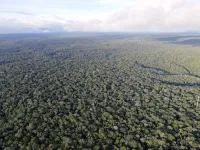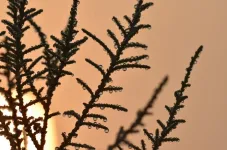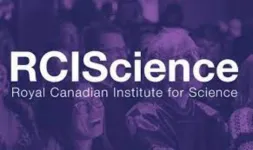(Press-News.org) From monitoring concentrations of greenhouse gases to detecting COVID in the breath, laser systems known as frequency combs can identify specific molecules as simple as carbon dioxide and as complex as monoclonal antibodies with unprecedented accuracy and sensitivity. Amazing as they are, however, frequency combs have been limited in how fast they can capture a high-speed process such as hypersonic propulsion or the folding of proteins into their final three-dimensional shapes.
Now, researchers at the National Institute of Standards and Technology (NIST), Toptica Photonics AG and the University of Colorado Boulder have developed a frequency comb system that can detect the presence of specific molecules in a sample every 20 nanoseconds, or billionths of a second. With this new capability, researchers can potentially use frequency combs to better understand the split-second intermediate steps in fast-moving processes ranging from the workings of hypersonic jet engines to the chemical reactions between enzymes that regulate cell growth. The research team announced its results in a paper published in Nature Photonics.
In their experiment, the researchers used the now-common dual-frequency comb setup, which contains two laser beams that work together to detect the spectrum of colors that a molecule absorbs. Most dual-frequency comb setups involve two femtosecond lasers, which send out a pair of ultrafast pulses in lockstep.
In this new experiment, the researchers used a simpler and cheaper setup known as “electro-optic combs,” in which a single continuous beam of light first gets split into two beams. Then, an electronic modulator produces electric fields that alter each light beam, shaping them into the individual “teeth” of a frequency comb. Each tooth is a specific color or frequency of light that can then be absorbed by a molecule of interest.
Whereas conventional frequency combs can have thousands or even millions of teeth, the researchers’ electro-optic comb only had 14 in a typical experimental run. However, as a result, each tooth had much higher optical power, and was far apart from others in frequency, resulting in a clear, strong signal that enabled the researchers to detect changes in the absorption of light at the 20-nanosecond time scale.
In their demonstration, the researchers used the instrument to measure supersonic pulses of CO2 emerging from a small nozzle in an air-filled chamber. They measured the CO2 mixing ratio, the proportion of carbon dioxide in the air. The changing concentration of CO2 told researchers about the motion of the pulse. The researchers saw how the CO2 interacted with the air and created oscillations of air pressure in its wake. Such details are often hard to accurately obtain even with the most sophisticated computer simulations.
“In a more complicated system like an aircraft engine we could use this approach to look at a particular species of interest, such as water or fuel or CO2, to observe the chemistry. We can also use this approach to measure things such as pressure, temperature or velocity by looking at changes in the signal,” said NIST research chemist David Long. The information from these experiments could provide insights that could lead to design improvements in combustion engines, or a better understanding of how greenhouse gases interact with the atmosphere.
A special component in the setup, known as an optical parametric oscillator, was used to shift the comb teeth from the near-infrared to the mid-infrared colors absorbed by CO2. But the optical parametric oscillator can also be tuned to other regions of the mid-infrared so that the combs can detect other molecules that absorb light in those regions.
The paper includes information that other researchers can use to build a similar system in the lab, making this new technique widely available across many research fields and industries.
“What is truly special about this work is that it substantially lowers the barrier to entry for researchers who would like to use frequency combs to study fast processes,” said co-author Greg Rieker, a professor at the University of Colorado Boulder and former NIST research associate.
“With this setup, you can generate any comb you want. The tunability, flexibility and speed of this method open the door to lots of different types of measurements,” Long said.
This work was supported in part by the Air Force Office of Scientific Research.
END
New frequency comb can identify molecules in 20-nanosecond snapshots
Laser-based system now has the ability to capture moment-to-moment details of high-speed processes such as hypersonic propulsion and protein folding.
2023-10-30
ELSE PRESS RELEASES FROM THIS DATE:
Hospital care for children has shifted from general hospitals to children’s hospitals over last 20 years
2023-10-30
CHAPEL HILL, NC – Historically, most children in the United States who needed to be hospitalized were treated at general hospitals that treat both children and adults. But the number of hospitals providing inpatient care for children has decreased over the last decade, and many of them struggled to keep up with the demand for children’s care during a viral infection surge in the fall of 2022.
Now children are much more likely to be treated at children’s hospitals that are concentrated into fewer locations, according to a new study led by UNC School of Medicine researchers.
“The ...
The brain may learn about the world the same way some computational models do
2023-10-30
CAMBRIDGE, MA -- To make our way through the world, our brain must develop an intuitive understanding of the physical world around us, which we then use to interpret sensory information coming into the brain.
How does the brain develop that intuitive understanding? Many scientists believe that it may use a process similar to what’s known as “self-supervised learning.” This type of machine learning, originally developed as a way to create more efficient models for computer vision, allows computational models to learn about visual scenes based solely on the similarities and differences between them, with no ...
Largest brain autopsy study of female intimate partner violence decedents reveals brain injury pathology unlike that seen among male contact sports athletes
2023-10-30
The largest brain autopsy study of women who had experienced intimate partner violence reveals substantial vascular and white matter damage in the brain, but no evidence of chronic traumatic encephalopathy (CTE), the neurodegenerative disease recognized among male contact sports athletes who sustain repeated head trauma.
The international collaboration, led by a team from the Brain Injury Research Center of Mount Sinai in collaboration with the New York City Office of the Chief Medical Examiner, appears in the most recent issue of Acta Neuropathologica.
Importantly, ...
Soy expansion in Brazil linked to increase in childhood leukemia deaths
2023-10-30
URBANA, Ill. – Over the past decades, Brazil has become the world’s leading soybean producer, as well as the leading consumer of pesticides. Despite concerns about potential public health consequences, little is known about the effects of pesticide exposure in the general population. A new study from the University of Illinois Urbana-Champaign in collaboration with the University of Denver and University of Wisconsin-Madison looks at how soy expansion and increased pesticide use in Brazil’s Cerrado and Amazon biomes correlate with increased childhood cancer mortality.
“The Brazilian Amazon region is undergoing a transition ...
Amazon deforestation linked to long distance climate warming
2023-10-30
Deforestation in the Amazon causes land surfaces up to 100 kilometres away to get warmer, according to a new study.
The research, by a team of British and Brazilian scientists, led by Dr Edward Butt at the University of Leeds, suggests that tropical forests play a critical role in cooling the land surface - and that effect can play out over considerable distances.
It is known that when tropical forests are cleared, the climate in the immediate vicinity gets warmer.
In this latest study, the researchers wanted to know if deforestation in the Amazon was resulting in climate warming further afield, and the study examined the impact of forest loss on sites up to ...
NYU Abu Dhabi researchers reveal how common desert shrub efficiently harvests water from the air
2023-10-30
Abu Dhabi, UAE, October 2023: A team of scientists, led by Post-Doctoral Associate Marieh Al-Handawi and Professor of Chemistry Panče Naumov from NYU Abu Dhabi’s Smart Materials Lab and NYU Abu Dhabi Institute’s Center for Smart Engineering Materials (CSEM) has revealed the mechanism a desert plant native to the United Arab Emirates uses to capture moisture from the desert air in order to survive. The identification of this unique mechanism, in which the plant excretes salts to extract and condense water onto the surface of its leaves, has the potential to inspire ...
Royal Canadian Institute for Science recognizes the unsung heroes of science communication
2023-10-30
The Royal Canadian Institute for Science (RCIScience) awards the 2023 Sandford Fleming Medal for Excellence in Science Communication to independent science writer Terry Collins and the William Edmond Logan Award to the team behind CBC Radio's national weekly science program, Quirks & Quarks.
A knowledge translator for over 27 years, Terry Collins' reporting has been picked up by journalists in Canada and worldwide, awakening public interest in and deepening understanding of diverse sciences, fostering political will and mobilizing resources for change.
Nominator Dr. Peter A. Singer, former Special Advisor to the Director-General of the World Health Organization, ...
Institute for Systems Biology and NED Biosystems announce collaboration to show how cancer’s onset may be reversed
2023-10-30
SEATTLE – Leroy Hood, MD, PhD, co-founder of Seattle’s Institute for Systems Biology (ISB) and a pioneer in systems biology, and Rebecca Lambert, founder and CEO of NED Biosystems, Inc. (NED), a public benefit corporation that is developing the first oral “systems treatment” for cancer, have entered into a memorandum of understanding to collaborate on a clinical trial to show how cancer’s onset may be reversed.
NED’s cancer treatment, NED-170, takes a systems approach that combines repurposed, oral agents that are well documented in humans to affect critical cancer disease-driver processes at doses that lack customary toxicity and side effects.
“A ...
Women with physical disabilities are less likely to be screened for cervical cancer than women without disabilities
2023-10-30
Around 11,500 new cases of cervical cancer are diagnosed each year in the United States, according to the Centers for Disease Control (CDC). The CDC tracks cervical cancer rates by age, race, and ethnicity, but not by disability type. A 2022 study found that women with disabilities may encounter multiple social and economic barriers to accessing reproductive health care, and a lack of timely access to cervical cancer screening may lead to delayed diagnosis and treatment for cervical cancer.
According to research by Mason PhD in Public Health ...
Department of Energy announces $11.4 million for research on quantum information science for fusion energy sciences
2023-10-30
WASHINGTON, D.C. - Today, the U.S. Department of Energy (DOE) announced $11.4 million for six projects in quantum information science (QIS) with relevance to fusion and plasma science.
The Fusion Energy Sciences (FES) program supports fundamental research to expand the understanding of matter at very high temperatures and densities and to build the scientific foundation needed to develop a fusion energy source. The QIS portfolio within FES supports research opportunities outlined in the 2018 Fusion Energy Sciences Roundtable on Quantum Information Science report. It includes science and technology thrusts where QIS might have a transformative impact on FES ...
LAST 30 PRESS RELEASES:
Strategic river sensors could have forewarned of Texas Camp flood disaster
Drone sampling of whale breath reveals first evidence of potentially deadly virus in Arctic
Roman soldiers defending Hadrian’s Wall infected by parasites, study finds
Pinochet’s prisoners were tormented with music but still found solace in it, a new book reveals
Fertility remains high in rural Tanzania despite access to family planning
AI-assisted device can improve autism care access
Kinetic careers
Uncovering how parasitic plants avoid attacking themselves to improve crop resistance
Nanoparticle vaccine strategy could protect against Ebola and other deadly filoviruses
Study finds brain care score can predict risk of stroke across racial groups
Key lung immune cells can intensify allergic reactions
Do hormones explain why women experience more gut pain?
New materials conduct ions in solids as easily as in liquids
Breakthrough of the Year: Renewable energy begins to eclipse fossil fuel-based sources
LLM use is reshaping scientific enterprise by increasing output, reducing quality and more
Introducing LightGen, a chip for ultra-fast, ultra-efficient generative AI
Astronomers see fireworks from violent collisions around nearby star
ACC/AHA issue new guideline on managing congenital heart disease in adults
Cosmic crash caught on camera
Is talented youth nurtured the wrong way? New study shows: top performers develop differently than assumed
Ants: An untapped resource in the development of antibiotics?
Archaeologists use AI to create prehistoric video game
Mitochondria migrate toward the cell membrane in response to high glucose levels
Tiny viral switch offers hope against drug-resistant bacteria
Most parents aware of early peanut introduction guidelines, but confused about details
HPV vaccine can protect against severe lesions of the vulva and vagina
Virtual care provision and emergency department use among children and youth
Quadrivalent HPV vaccine and high-grade vulvovaginal lesions
Insights into dry eyes gained from stem cell-derived tear glands
Researchers identify 166 human pluripotent stem cell lines available for use in clinical applications
[Press-News.org] New frequency comb can identify molecules in 20-nanosecond snapshotsLaser-based system now has the ability to capture moment-to-moment details of high-speed processes such as hypersonic propulsion and protein folding.




